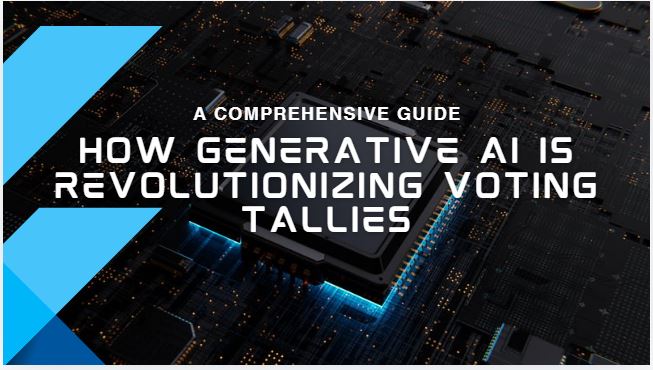
Introduction
In recent years, the intersection of technology and democracy has become increasingly prominent. One area where this convergence is particularly evident is in the use of Generative AI for voting tallies. This cutting-edge technology is reshaping how we count and verify votes, promising to enhance accuracy, speed, and transparency in electoral processes. Whether you’re a student exploring the latest advancements in AI or a working professional interested in its real-world applications, understanding the role of Generative AI in voting systems is crucial.
What is Generative AI?
Before diving into its application in voting tallies, let’s clarify what Generative AI is. Generative AI refers to artificial intelligence systems that can create new content, whether it’s text, images, or even complex data patterns. These systems learn from existing data and use that knowledge to generate new, original outputs.
Key Features of Generative AI:
- Pattern Recognition: Ability to identify complex patterns in data
- Content Creation: Can produce new, unique content based on learned patterns
- Adaptability: Continuously learns and improves its outputs
- Scalability: Can handle large amounts of data efficiently
For those interested in delving deeper into this field, taking an AI ML course or an online AI ML course can provide a solid foundation in the principles and applications of Generative AI.
The Traditional Voting Tally Process
To appreciate the impact of Generative AI on voting tallies, it’s essential to understand the traditional process:
- Manual Counting: Votes are typically counted by hand, which is time-consuming and prone to human error.
- Verification: Multiple people often recount to ensure accuracy, adding more time to the process.
- Reporting: Results are compiled and reported, sometimes with delays due to the manual nature of the process.
- Auditing: Post-election audits are conducted to verify the accuracy of the results.
While tried and tested, this process has speed, accuracy, and scalability limitations, especially in large-scale elections.
How Generative AI is Transforming Voting Tallies
Generative AI is addressing many of the challenges associated with traditional voting tallies. Here’s how:
1. Enhanced Accuracy
Generative AI systems can process and count votes accurately surpasses human capabilities. By learning from vast datasets of ballot images and vote counts, these systems can identify and correctly interpret various ballots, even those with unusual markings or errors.
“The accuracy of Generative AI in vote counting can significantly reduce the margin of error in election results, enhancing the integrity of the democratic process.”
2. Increased Speed
One of the most significant advantages of using Generative AI for vote tallying is the dramatic increase in speed. While manual counting can take days or weeks for large elections, AI systems can process millions of votes in hours.
3. Pattern Detection and Fraud Prevention
Generative AI excels at detecting patterns. In the context of voting tallies, this means:
- Identifying unusual voting patterns that might indicate fraud
- Detecting inconsistencies in ballot markings or vote distributions
- Flagging potential irregularities for human review
This capability adds an extra layer of security to the electoral process, helping to ensure the integrity of elections.
4. Improved Accessibility and Transparency
By automating the vote-counting process, Generative AI can make election results more accessible to the public. Real-time updates and detailed breakdowns of vote counts can be provided, increasing transparency and public trust in the electoral system.
The Technical Side: How Generative AI Works in Vote Tallying
For those considering an AI ML course or an online AI ML course, understanding the technical aspects of how Generative AI works in vote tallying can be fascinating:
- Data Input: Scanned images of ballots are fed into the AI system.
- Image Processing: The AI uses computer vision techniques to analyze the ballot images.
- Pattern Recognition: Machine learning algorithms identify vote marks and interpret them.
- Data Aggregation: The AI system compiles the interpreted votes into a comprehensive tally.
- Anomaly Detection: The system flags any unusual patterns or potential errors for human review.
This process combines AI and machine learning techniques, including convolutional neural networks for image processing and anomaly detection algorithms.
Challenges and Considerations
While the potential of Generative AI in vote tallying is enormous, it’s not without challenges:
1. Data Privacy and Security
Ensuring the privacy and security of voter data is paramount. AI systems must be designed with robust security measures to prevent hacking or data breaches.
2. Transparency and Trust
There may be public skepticism about trusting AI with such a crucial democratic process—transparency in how the AI works and regular audits are essential to build and maintain public trust.
3. Bias and Fairness
AI systems can inadvertently perpetuate biases present in their training data. Ensuring fairness and neutrality in vote counting AI is crucial.
4. Integration with Existing Systems
Implementing AI-based voting tally systems requires careful integration with existing electoral infrastructure, which can be complex and vary by region.
The Future of Voting with Generative AI
As Generative AI continues to evolve, its role in voting tallies will likely expand. Some potential future developments include:
- Blockchain Integration: Combining Generative AI with blockchain technology for even more secure and transparent vote recording.
- Natural Language Processing: AI systems that can interpret write-in votes or complex ballot measures.
- Predictive Analytics: Using AI to forecast voting patterns and turnout, helping election officials better prepare for elections.
The Role of Education in Advancing AI in Elections
Education plays a crucial role for students and professionals interested in this field. Taking an AI ML course or an online AI ML course can provide the knowledge and skills needed to contribute to this exciting area of technology.
Key areas of study in such courses might include:
- Machine Learning Algorithms
- Computer Vision
- Natural Language Processing
- Data Privacy and Security
- Ethical AI Development
Conclusion
Generative AI is poised to revolutionize the way we conduct and verify elections. Enhancing accuracy, speed, and transparency in vote tallying has the potential to strengthen democratic processes worldwide. However, its implementation must be carefully managed to address security, trust, and fairness challenges.
For those fascinated by this intersection of technology and democracy, pursuing knowledge through an AI ML course or an online AI ML course can open doors to contributing to this critical field. As we progress, the responsible development and application of Generative AI in voting systems will be crucial in shaping the future of elections and, by extension, democracy.
Whether you’re a student looking to enter this field or a professional seeking to understand its implications, staying informed about the advancements in Generative AI and its applications in voting systems is not just interesting—it’s essential for participating in the future of our democratic processes.



